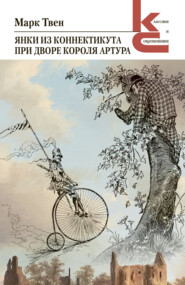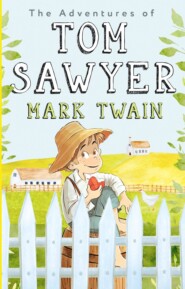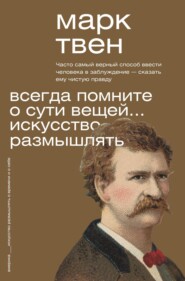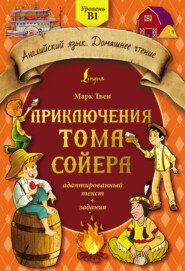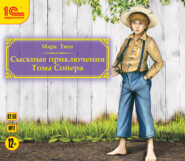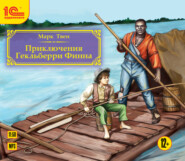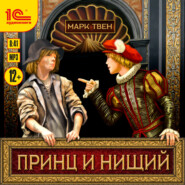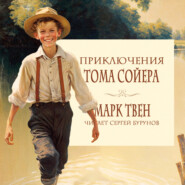По всем вопросам обращайтесь на: info@litportal.ru
(©) 2003-2024.
✖
A Double Barrelled Detective Story
Автор
Год написания книги
2015
Настройки чтения
Размер шрифта
Высота строк
Поля
III
The tavern dining-room had been cleared of all its furniture save one six-foot pine table and a chair. This table was against one end of the room; the chair was on it; Sherlock Holmes, stately, imposing, impressive, sat in the chair. The public stood. The room was full. The tobacco-smoke was dense, the stillness profound.
The Extraordinary Man raised his hand to command additional silence; held it in the air a few moments; then, in brief, crisp terms he put forward question after question, and noted the answers with “Um-ums,” nods of the head, and so on. By this process he learned all about Flint Buckner, his character, conduct, and habits, that the people were able to tell him. It thus transpired that the Extraordinary Man’s nephew was the only person in the camp who had a killing-grudge against Flint Buckner. Mr. Holmes smiled compassionately upon the witness, and asked, languidly—
“Do any of you gentlemen chance to know where the lad Fetlock Jones was at the time of the explosion?”
A thunderous response followed—
“In the billiard-room of this house!”
“Ah. And had he just come in?”
“Been there all of an hour!”
“Ah. It is about – about – well, about how far might it be to the scene of the explosions.”
“All of a mile!”
“Ah. It isn’t much of an alibi, ’tis true, but—”
A storm-burst of laughter, mingled with shouts of “By jiminy, but he’s chain-lightning!” and “Ain’t you sorry you spoke, Sandy?” shut off the rest of the sentence, and the crushed witness drooped his blushing face in pathetic shame. The inquisitor resumed:
“The lad Jones’s somewhat distant connection with the case” (laughter) “having been disposed of, let us now call the eye-witnesses of the tragedy, and listen to what they have to say.”
He got out his fragmentary clues and arranged them on a sheet of cardboard on his knee. The house held its breath and watched.
“We have the longitude and the latitude, corrected for magnetic variation, and this gives us the exact location of the tragedy. We have the altitude, the temperature, and the degree of humidity prevailing – inestimably valuable, since they enable us to estimate with precision the degree of influence which they would exercise upon the mood and disposition of the assassin at that time of the night.”
(Buzz of admiration; muttered remark, “By George, but he’s deep!”) He fingered his clues. “And now let us ask these mute witnesses to speak to us.
“Here we have an empty linen shot-bag. What is its message? This: that robbery was the motive, not revenge. What is its further message? This: that the assassin was of inferior intelligence – shall we say light-witted, or perhaps approaching that? How do we know this? Because a person of sound intelligence would not have proposed to rob the man Buckner, who never had much money with him. But the assassin might have been a stranger? Let the bag speak again. I take from it this article. It is a bit of silver-bearing quartz. It is peculiar. Examine it, please – you – and you – and you. Now pass it back, please. There is but one lode on this coast which produces just that character and color of quartz; and that is a lode which crops out for nearly two miles on a stretch, and in my opinion is destined, at no distant day, to confer upon its locality a globe-girdling celebrity, and upon its two hundred owners riches beyond the dreams of avarice. Name that lode, please.”
“The Consolidated Christian Science and Mary Ann!” was the prompt response.
A wild crash of hurrahs followed, and every man reached for his neighbor’s hand and wrung it, with tears in his eyes; and Wells-Fargo Ferguson shouted, “The Straight Flush is on the lode, and up she goes to a hunched and fifty a foot – you hear me!”
When quiet fell, Mr. Holmes resumed:
“We perceive, then, that three facts are established, to wit: the assassin was approximately light-witted; he was not a stranger; his motive was robbery, not revenge. Let us proceed. I hold in my hand a small fragment of fuse, with the recent smell of fire upon it. What is its testimony? Taken with the corroborative evidence of the quartz, it reveals to us that the assassin was a miner. What does it tell us further? This, gentlemen: that the assassination was consummated by means of an explosive. What else does it say? This: that the explosive was located against the side of the cabin nearest the road – the front side – for within six feet of that spot I found it.
“I hold in my fingers a burnt Swedish match – the kind one rubs on a safety-box. I found it in the road, six hundred and twenty-two feet from the abolished cabin. What does it say? This: that the train was fired from that point. What further does it tell us? This: that the assassin was left-handed. How do I know this? I should not be able to explain to you, gentlemen, how I know it, the signs being so subtle that only long experience and deep study can enable one to detect them. But the signs are here, and they are reinforced by a fact which you must have often noticed in the great detective narratives – that all assassins are left-handed.”
“By Jackson, that’s so!” said Ham Sandwich, bringing his great hand down with a resounding slap upon his thigh; “blamed if I ever thought of it before.”
“Nor I!” “Nor I!” cried several. “Oh, there can’t anything escape him – look at his eye!”
“Gentlemen, distant as the murderer was from his doomed victim, he did not wholly escape injury. This fragment of wood which I now exhibit to you struck him. It drew blood. Wherever he is, he bears the telltale mark. I picked it up where he stood when he fired the fatal train.” He looked out over the house from his high perch, and his countenance began to darken; he slowly raised his hand, and pointed—
“There stands the assassin!”
For a moment the house was paralyzed with amazement; then twenty voices burst out with:
“Sammy Hillyer? Oh, hell, no! Him? It’s pure foolishness!”
“Take care, gentlemen – be not hasty. Observe – he has the blood-mark on his brow.”
Hillyer turned white with fright. He was near to crying. He turned this way and that, appealing to every face for help and sympathy; and held out his supplicating hands toward Holmes and began to plead,
“Don’t, oh, don’t! I never did it; I give my word I never did it. The way I got this hurt on my forehead was—”
“Arrest him, constable!” cried Holmes. “I will swear out the warrant.”
The constable moved reluctantly forward – hesitated – stopped.
Hillyer broke out with another appeal. “Oh, Archy, don’t let them do it; it would kill mother! You know how I got the hurt. Tell them, and save me, Archy; save me!”
Stillman worked his way to the front, and said,
“Yes, I’ll save you. Don’t be afraid.” Then he said to the house, “Never mind how he got the hurt; it hasn’t anything to do with this case, and isn’t of any consequence.”
“God bless you, Archy, for a true friend!”
“Hurrah for Archy! Go in, boy, and play ’em a knock-down flush to their two pair ‘n’ a jack!” shouted the house, pride in their home talent and a patriotic sentiment of loyalty to it rising suddenly in the public heart and changing the whole attitude of the situation.
Young Stillman waited for the noise to cease; then he said,
“I will ask Tom Jeffries to stand by that door yonder, and Constable Harris to stand by the other one here, and not let anybody leave the room.
“Said and done. Go on, old man!”
“The criminal is present, I believe. I will show him to you before long, in case I am right in my guess. Now I will tell you all about the tragedy, from start to finish. The motive wasn’t robbery; it was revenge. The murderer wasn’t light-witted. He didn’t stand six hundred and twenty-two feet away. He didn’t get hit with a piece of wood. He didn’t place the explosive against the cabin. He didn’t bring a shot-bag with him, and he wasn’t left-handed. With the exception of these errors, the distinguished guest’s statement of the case is substantially correct.”
A comfortable laugh rippled over the house; friend nodded to friend, as much as to say, “That’s the word, with the bark on it. Good lad, good boy. He ain’t lowering his flag any!”
The guest’s serenity was not disturbed. Stillman resumed:
“I also have some witnesses; and I will presently tell you where you can find some more.” He held up a piece of coarse wire; the crowd craned their necks to see. “It has a smooth coating of melted tallow on it. And here is a candle which is burned half-way down. The remaining half of it has marks cut upon it an inch apart. Soon I will tell you where I found these things. I will now put aside reasonings, guesses, the impressive hitchings of odds and ends of clues together, and the other showy theatricals of the detective trade, and tell you in a plain, straightforward way just how this dismal thing happened.”
He paused a moment, for effect – to allow silence and suspense to intensify and concentrate the house’s interest; then he went on:
“The assassin studied out his plan with a good deal of pains. It was a good plan, very ingenious, and showed an intelligent mind, not a feeble one. It was a plan which was well calculated to ward off all suspicion from its inventor. In the first place, he marked a candle into spaces an inch apart, and lit it and timed it. He found it took three hours to burn four inches of it. I tried it myself for half an hour, awhile ago, up-stairs here, while the inquiry into Flint Buckner’s character and ways was being conducted in this room, and I arrived in that way at the rate of a candle’s consumption when sheltered from the wind. Having proved his trial candle’s rate, he blew it out – I have already shown it to you – and put his inch-marks on a fresh one.
“He put the fresh one into a tin candlestick. Then at the five-hour mark he bored a hole through the candle with a red-hot wire. I have already shown you the wire, with a smooth coat of tallow on it – tallow that had been melted and had cooled.
“With labor – very hard labor, I should say – he struggled up through the stiff chaparral that clothes the steep hillside back of Flint Buckner’s place, tugging an empty flour-barrel with him. He placed it in that absolutely secure hiding-place, and in the bottom of it he set the candlestick. Then he measured off about thirty-five feet of fuse – the barrel’s distance from the back of the cabin. He bored a hole in the side of the barrel – here is the large gimlet he did it with. He went on and finished his work; and when it was done, one end of the fuse was in Buckner’s cabin, and the other end, with a notch chipped in it to expose the powder, was in the hole in the candle – timed to blow the place up at one o’clock this morning, provided the candle was lit about eight o’clock yesterday evening – which I am betting it was – and provided there was an explosive in the cabin and connected with that end of the fuse – which I am also betting there was, though I can’t prove it. Boys, the barrel is there in the chaparral, the candle’s remains are in it in the tin stick; the burnt-out fuse is in the gimlet-hole, the other end is down the hill where the late cabin stood. I saw them all an hour or two ago, when the Professor here was measuring off unimplicated vacancies and collecting relics that hadn’t anything to do with the case.”
He paused. The house drew a long, deep breath, shook its strained cords and muscles free and burst into cheers. “Dang him!” said Ham Sandwich, “that’s why he was snooping around in the chaparral, instead of picking up points out of the P’fessor’s game. Looky here – he ain’t no fool, boys.”







